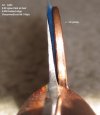I just got a Benchmade Barrage at a local hardware store. I wasn't planning to buy a knife, but I saw this model with a beautiful aluminum bolster and G10 scales that I just had to look at. Once I snapped it open (it's an auto), I could immediately see that the blade and edge geometry were awesome. Thin blade. Very thin edge. Pointy point. And the steel was M390.
When I got it home, I checked out the specifics. The edge angle is 22 degrees -- and this is a factory edge that is very sharp. The width behind the edge is just 0.0155 inches. This thing reeks with quality and cuts like a demon laser. Might be what the OP is looking for -- great steel, great geometry, great knife.
When I got it home, I checked out the specifics. The edge angle is 22 degrees -- and this is a factory edge that is very sharp. The width behind the edge is just 0.0155 inches. This thing reeks with quality and cuts like a demon laser. Might be what the OP is looking for -- great steel, great geometry, great knife.

